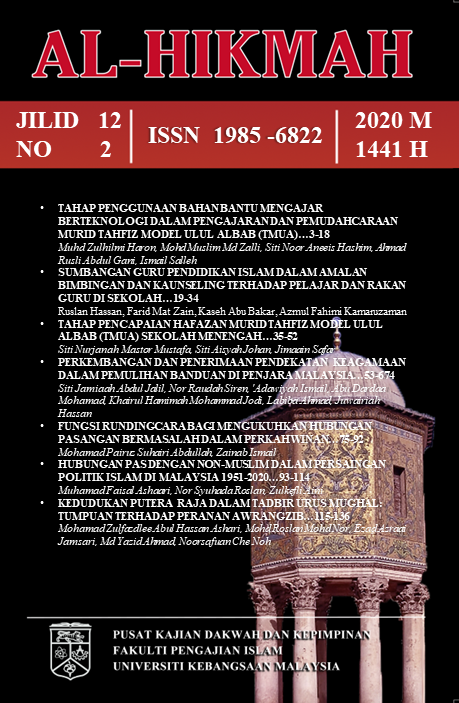A PRINCE’S ROLE IN THE MUGHAL GOVERNANCE: FOCUS ON AWRANGZIB
Peranan Putera Raja dalam Tadbir Urus Mughal: Tumpuan Terhadap Awrangzib
Abstract
Awrangzib or Aurangzeb is acknowledged as the best among the Moghul rulers in the Age of the Great Moghuls. His efforts in ensuring the stability of Moghul reign are the primary indicator that places him on par with Akbar the Great. However, his role in Moghul governance did not just begin on becoming an Emperor. Instead, he was earlier already governing as a prince. This research examines the prince’s role as an institution of Moghul governance by focusing on Aurangzeb’s roles, particularly during his father, Shah Jahan. This study is a qualitative research within using the historical study and content analysis as the research design. Research findings show that Aurangzeb played the primary roles of military leader and governor. Such roles ensured the stability of Moghul rule despite various challenges. His experience in governing the Moghul kingdom while he was a prince shaped and influenced his Moghul policies when he ascended to the throne in 1657.
References
Abdullah Ishak. 1992. Islam di India, Nusantara dan China. Kuala Lumpur: Nurin Enterprise.
Agrawal, C.M. 2000. Aurangzeb and His Wazirs. Delhi: Indian Publishers Distributors.
Azharudin Mohamed Dali. 2014. Sejarah Islam di India Abad ke-8 hingga Abad ke-20. Kuala Lumpur: Dewan Bahasa dan Pustaka.
Bakshi, S.R. & Sharma, S.K. 1999. The Great Moghuls: Aurangzeb. Jil. 6. New Delhi: Deep & Deep Publications Pvt. Ltd.
Bouillier, V. 2018. Aurangzeb and the Nath Yogis. Journal of the Royal Asiatic Society 28(3): 525-535.
Burgess, J. 1972. The Chronology of Indian History. Delhi: Cosmo Publications.
Faruki, Z. 1972. Aurangzeb & His Times. Delhi: Idarah-I Adabiyat.
Fisher, M. H. 2016. A Short History of The Mughal Empire. London: I.B. Tauris & Co. Ltd.
Foltz, R. 1996. The Mughal occupation of Balkh 1646-1647. Journal of Islamic Studies 7(1): 49-61.
Hamka. 2006. Sejarah Umat Islam. Singapura: Pustaka Nasional Pte. Ltd.
Haq, S.M. 1962. Prince Awrangzib: A study (1). Journal of the Pakistan Historical Study X(I): 1-24.
Husain, Z. 2010. Aurangzeb’s First Viceroyalty of the Deccan: A Reappraisal, Proceedings of The Indian History Congress 70: 310-318.
Hussain, M.F. 2014. Mughal princes and state formation. International Journal of Innovative Research & Development 3(2): 263-266.
Ismail Bakar. 2000. Sejarah dan Tamadun Islam di India. Bangi: Jabatan Pengajian Arab dan Tamadun Islam, Fakulti Pengajian Islam, Universiti Kebangsaan Malaysia.
Joshi, R. 1979. Aurangzeb-Attitudes and Inclinations. Delhi: Munshiran Manoharlal Publishers Pvt. Ltd.
Khafi Khan. 1870. Muntakhab al-Lubab. Jil. 1. Calcutta: Asiatic Society of Bengal.
Khalidi, Omar. 1992. The Shiah’s of the Deccan: An introduction. Hamdard Islamicus XV (4): 31-52.
Khan, ‘Inayat. 1990. The Shah Jahan Nama of ‘Inayat Khan. Sunt. Begley, W.E. & Desai, Z.A. New Delhi: Oxford University Press.
Kulke, H. & Rothermund, D. 2004. A History of India. New York: Routledge.
Lane-Poole, S. 1901. Aurangzib and The Decay of the Mughal Empire. Oxford: Oxford University Press.
Mohamad Zulfazdlee Abul Hassan Ashari & Mohd Roslan Mohd Nor. 2013. Kepemimpinan Awrangzib (1658-1707M) dan usaha menstabilkan Kerajaan Mughal: Satu kerangka konspetual. Prosiding Seminar Penyelidikan Siswazah UniSZA 2013, hlm. 297-304.
Mohamad Zulfazdlee Abul Hassan Ashari, Mohd Roslan Mohd Nor, Ezad Azraai Jamsari & Nursafira Ahmad Safian. 2013. Kerajaan Mughal di India menurut buku Sejarah Umat Islam karya Hamka. Prosiding Nadwah Ulama Nusantara (V): Ulama dan Cabaran Idealisme Semasa, hlm. 99-109.
Mohd Roslan Mohd Nor & Mohamad Zulfazdlee Abul Hassan Ashari. 2017. Kemelut politik Mughal pada penghujung era pemerintahan Shah Jahan. Jurnal Usuluddin 45(1): 27-59.
Naqvi, H.K. 1977. Aurangzeb’s policies and the decline of the Mughal Empire. The Journal of Asian Studies 37(1): 191-192.
Naqvi, H.K. 1990. History of Mughal Government and Administration, Delhi: Kanishka Publishing House.
Nicoll, F. 2009. Shah Jahan: The Rise and Fall of the Mughal Emperor. London: Haus Publishing Ltd.
Pandey, A.B. 1963. Later Medieval India: A History of the Mughals. Allahabad: Central Book Depot.
Pearson, M.N. 1976 Shivaji and the decline of the Mughal Empire. The Journal of Asian Studies 35(2): 221-235.
Rashid, Abdur. 1974. Shah Jahan. Dlm. Majumdar, R.C. (pnyt.). The History and Culture of The Indian People: The Mughul Empire. Bombay: Bharatiya Vidya Bhavan.
Richards, J.F. 2008. The New Cambridge History of India: The Mughal Empire. Cambridge: Cambridge University Press.
Sarkar, J. 1912. History of Aurangzib. Jil. 1. Calcutta: M.C. Sarkar & Sons Private Ltd.
Sarkar, J. 1963. Anecdotes of Aurangzib. Calcutta: M.C. Sarkar & Sons Private Ltd.
Schimmel, A. 2005. The Empire of the Great Mughals: History, Art and Culture. Lahore: Sang-E-Meel Publications.
Sharma, S.R. 1962. The Religious Policy of the Mughal Emperors. Bombay: Asia Publishing House.
Srivastava, A.L. 1957. The Mughal Empire (1526-1803 A.D.). Agra: Shiva Lal Agarwala & Co. Pvt. Ltd.
Truschke, A. 2017. Aurangzeb: The Life and Legacy of India’s Most Controversial King. Stanford: Stanford University Press.
Copyright (c) 2020 Al-Hikmah

This work is licensed under a Creative Commons Attribution-NonCommercial-NoDerivatives 4.0 International License.
Authors retain copyright and grant the journal right of first publication with the work simultaneously licensed under a Creative Commons Attribution License (CC BY-SA 4.0) that allows others to share the work with an acknowledgement of the work's authorship and initial publication in this journal.





